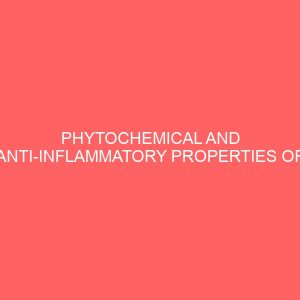Description
CHAPTER ONE
1.0 INTRODUCTION
This research is on Phytochemical analysis and the anti-inflammatory activities of methanol extract of crateva adansonii. Anti inflammatory refers to the property of a substance or treatment that reduces inflammation. Anti inflammatory drugs make up about half of analgesics, reducing pain by inhibiting inflammation as opposed to opioids, which affect the central nervous system published by Artemis Morris, molly Rossiter.
Inflammation Latin, inflammo, I ignite, set alight is part of the complex biological response of vascular tissues to harmful stimuli, such as pathogens, damaged cells, or irritants. The classical signs of inflammation are pain, heat, redness, swelling and loss of function by Dr Weil. Inflammation is a protective attempt by the organism to remove the injurious stimuli and initiate the healing process.
Inflammation is not a synonym for infection, even in cases where inflammation is caused by infection. Although infection is caused by a microorganism, and organism pathogen.
Inflammation is a setereotyped response and is considered as a mechanism of innate immunity by Dr. Weil.
1.1 TYPES OF INFLAMMATION
Inflammation can be classified as either acute or chronic. Acute inflammation, is the initial response of the body to harmful stimuli and is achieved by the increased movement of plasma and leukocytes especially granulocytes from the blood into the injured tissues.
Prolonged inflammation, known as chronic inflammation, leads to a progressive shift in the type of cells present at the site of inflammation and is characterized by simultaneous destruction and healing of the tissues from the inflammatory process from Wikipedia, the free encyclopedia.
1.2. AIMS AND OBJECTIVES
Evaluation of the anti inflammatory activity of crateva adansonii plant. The purpose of this study was to evaluate and compare the antiinflammatory activity of the aqueous sten bark extract of crateva adansonii in experimental acute and chronic inflammatory animal models. And to evaluate the phytochemical constituents and pharmacological evaluation of the effect of crateva adansonii on albino rats.
1.3 RATIONAL STUDY
Crateva adansonii was described in 1824 by Augstin Pyramus de candolle.
Crateva adansonii is a specie of a flowering tree in the capparancea family, which is equally called the sacred garlic pear and temple plant, and many other names in a variety of dialects, including Balai lamoke, barnaj Vanina and bidasi. The tree is sometimes called the spider tree because the showy flowers bear long, spidery stamens. It is native to Japan,
Australia, much of South East Asia and several south practice Islands India it is grown else where for fruit, especially in parts of the African continents.
The fruit of the tree is edible. The flowers are attractive to a multitude of insects and birds. The butterfly Hebomoia glaucippe is a frequent visitor to this plant by Dr. Weil.
1.4 TAXONOMY
Crateva Adansonii is a species in the genus crateva, which contains 8 species and belongs to the family of Capparacea caper family








Reviews
There are no reviews yet.